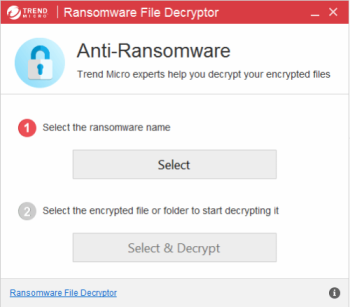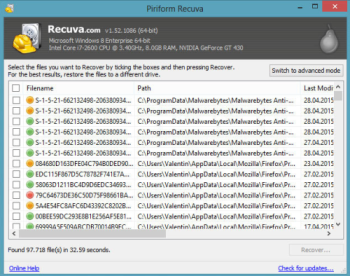What is Thor ransomware?
Thor ransomware is a encrypting successor of ill-famed Locky ransomware, a threat that already has many variants. However, it significantly differs from previous editions of the virus. First of all, it combines RSA and AES ciphers, which makes decryption of files way more difficult than before. Second, now it is capable of scattering over 400 file types. Altogether these factors make the malware a serious hazard to information safety. After the encryption the files become blocked and victims are given a choice – to pay 0.5 Bitcoin as a ransom or forget about their data. Though there are different approaches to the ransomware removal, the majority of specialists agree in the opinion that users shouldn’t transfer the money, as it allows the cybercriminals to continue their rogue practices. Instead of wasting your money on this unfair deal, we encourage you to attempt to remove Thor ransomware by yourself.

How Thor ransomware got installed on your computer
All releases of Locky ransomware were similar in methods of distribution. The most part of its victims got the malware from infected email attachments, among other cases there is distribution via exploit kits and malicious websites. The extensions of the files that were registered as carrying Thor ransomware are the following: .doc, .dll, .hsa, .js, .vbs, and .zip, so be careful when getting these from an unknown or a suspicious sender. Since the harm that a ransomware does is irreversible, we underscore the importance of being on guard and having a proper antivirus and antimalware defences.
Symptoms of Thor ransomware infection
It’s difficult not to notice ransomware, since it often has one of the processes responsible for displaying a notification message. This window blocks the screen leaving the user minimum alternatives. Besides, some files will be inaccessible, as in many cases ransomware encrypts them to exasperate the scaring effect.
What to do if your PC is infected with Thor ransomware
As soon as you notice the presence of the ransomware on your system, you should turn your computer off. If it is possible try to create a backup or image of your hard drive info. This may let you to reserve the state of your drives in case a decryption method would be created afterwards.
How to remove Thor ransomware?
To make sure that the adware won’t reappear, you need to delete Thor ransomware completely. For this you need to remove the files and registry entries of the ransomware. We should warn you that performing some of the steps may require above-average skills, so if you don’t feel experienced enough, you may apply to automatic removal tool.
Performing an antimalware scan with Norton would automatically search out and delete all elements related to Thor ransomware. It is not only the easiest way to eliminate Thor ransomware, but also the safest and the most assuring one.
Steps of Thor ransomware manual removal
Restart Windows in Safe Mode
For Windows XP:
- Restart the system
- While computer is rebooting press F8 several times
- In the appeared list of options choose Safe Mode
For Windows 7 and Vista:
- Restart the system
- While computer is rebooting press F8 several times
- In the appeared list of options choose Safe Mode
For Windows 8 and 8.1:
- Restart the system
- While computer is rebooting press F8 several times
- In the appeared list of options choose Safe Mode
For Windows 10:
- In the Start menu click on the power button
- Hold Shift and choose Restart
- Choose Troubleshoot
- In the Advanced Options choose Startup Settings
- Click Restart
- Select Enter Safe Mode
Delete files and registry entries added by Thor ransomware
Now you will be able to reach the needed functions and files. For eliminating the ransomware activity, you need to find all of the following items and delete them.
Remove Thor ransomware files and folders:
\Windows\SysWOW64\rundll32.exe %Temp%\MWGUBR~1.dll,EnhancedStoragePasswordConfig 147
How to decrypt and restore .thor files
Use the decrypting tool

Trend Micro Ransomware File Decryptor is one of those tools that can be of an inestimable help in decrypting .thor files. Since the tool has the wide base of ransomware threats and required no fee for using, so you definitely should try to decipher the files with it.
Restore .thor files with an automatic tool
For those types of ransomware viruses that rather remove files than encrypt them we would suggest using Recuva program.

- Download Recuva tool and launch it
- Within the on-screen wizard choose the type of the files you want to recover
- Choose the location of the files
- Wait until the application finishes scanning
- Select the required files and click the Recover button
Nevertheless there are no other tools able to restore and decrypt .thor files, you may try applying to the manual methods described below, however, they might not work with the latest versions of Thor ransomware.
Restore the system
- Initiate the search for system restore
- Click on the result
- Choose the date before the infection appearance
- Follow the on-screen instructions
Roll the files back to the previous version
- Right-click the file and choose Properties
- Open the Previous Version tab
- Select the latest version and click Copy
- Click Restore
If the above-mentioned methods didn’t help in eliminating the threat, then it’s better to rely on an automatic way of deleting Thor ransomware.
We also recommend to download and use Norton to scan the system after Thor ransomware removal to make sure that it is completely gone. The antimalware application will detect any vicious components left among system files and registry entries that can recover Thor ransomware.




